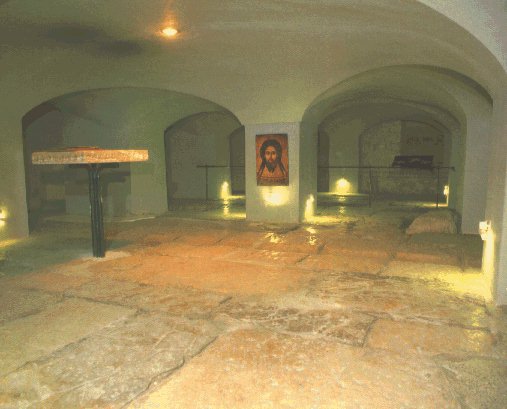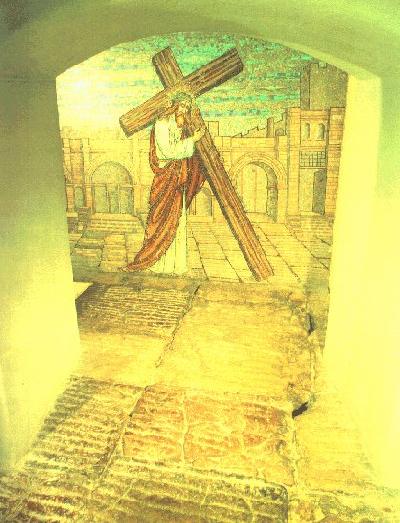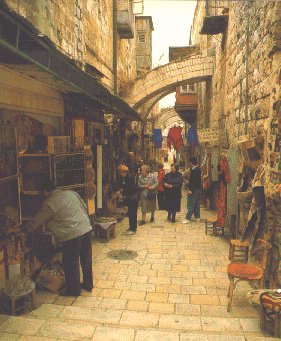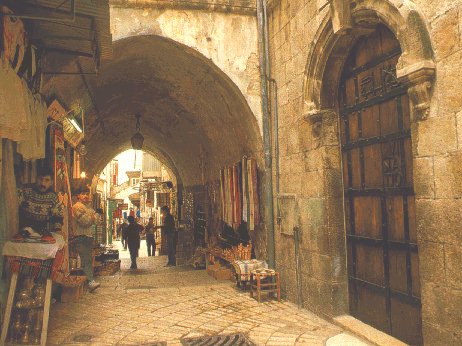 |
 |
 |
 |
Note: Image number will appear in the pop-up line when you will point your mouse on the pictures of Jerusalem. The image number corresponds to the notes number below
175 = The Lithostrotos Convent of the Sisters of Zion
The construction of the convent, for the sisters of Zion began in 1859. In 1868 the church was completed and it was declard a minor basilica in 1902. The court of the Lithostros was 44.5 m wide and 54 m long the flagstones still cover almost the whole surface. Most interesting are the games cut in the flagstones.
Lithostrotos
The public part of the trial of Jesus took place in the
Lithostrotos and the private part of the Jesus trial took place in the
palace. Although Christ received his death sentence in the Lithostrotos,
yet it is the custom to begin the Way of the Cross in the palace.
176 = The pavement where Jesus was tried before Pontius Pilate and condemned to death Chapel of Condemnation and where He took the cross.
 |
 |
 |
 |
Note: Image number will appear in the pop-up line when you will point your mouse on the pictures of Jerusalem. The image number corresponds to the notes number below
177 = The King's Game
178 = The Via Dolorsa
Ecce Homo Convent archaelogical
remains and Ecce Homo Arch.
The excavations include the Struthion Pool, some Roman
pavement, and the Ecce Homo Triumphal Arch. The convent is believed to
be just north of where Herod's Antonia Fortress stood, surrounded by a
moat. Herod had it built in 30 BCE, destroying part of the canal (built
by the Hasmoneans in 2nd century BCE to provide water to the Temple Mount
cisterns) when the moat was dug. A reservoir (the Struthion Pool, a part
of the moat) replaced the canal to serve the fortress. The pool was later
vaulted over by Hadrian (2nd century CE) and turned into a cistern.
Much of the convent is built over the cistern remains. The Roman pavement was laid above the cistern and seved as plaza. Hadrian's triple Triumphal Arch formed a gate to the plaza, and the largest one was known as Ecco Homo Arch. This arch now marks the spot the church remembers for Jesus trial before Pilat (John 19: 5) and his latin words "Ecce Homo" (meaning "Behold the man").
The King's Game
The pavement - Is one of the most interesting sites in
the Holy Land. It is a part of the Lythostrotos. The pavement goes back
to the Roman times. Traces of games played by the Roman soldiers are carved
on the surface of some of the stones. One of the games which was very popular
in the Roman army is "Game of the King."
179 = The Via Dolorosa The Way of Sorrows
Is the traditional road which our Lord & Saviour followed
carrying the cross from the Judgment hall - Praetorium to Calvary.
The events of this sorrowful way are commemorated by
fourteen stations.
Every Friday at 3.00 pm the Franciscans conduct a ceremony
along the Via Dolorosa.
180 = Another scene in the Via Dolorosa
Drs.Koudinov Office
|| Drs.Koudinov Holy Land || step
back || continue the tour || Jerusalem
and Holy Land maps
To stop audio press STOP button on the Internet Explorer toolbar